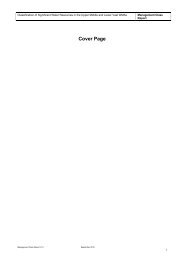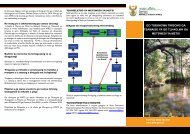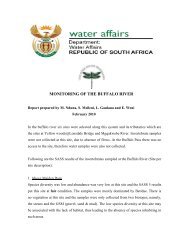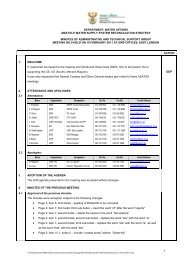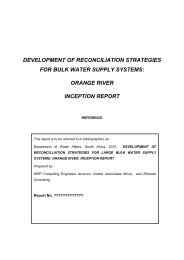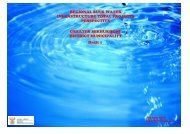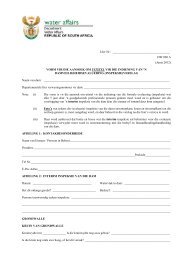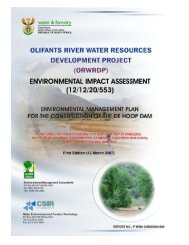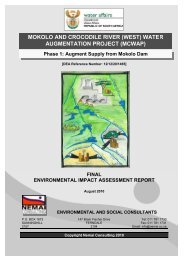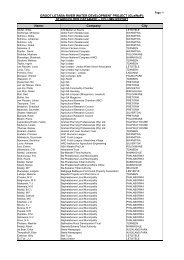Final Interventions Report - DWA Home Page
Final Interventions Report - DWA Home Page
Final Interventions Report - DWA Home Page
You also want an ePaper? Increase the reach of your titles
YUMPU automatically turns print PDFs into web optimized ePapers that Google loves.
Water Reconciliation Strategy Study for the Large Bulk Water Supply Systems: Greater Bloemfontein Area 36<br />
Water stored in the Kalkfontein Dam (Riet River) is released in the Kalkfontein canal for the irrigation<br />
farmers. No river releases are made.<br />
The Orange-Riet WUA pump water out of the main canal from the Vanderkloof Dam. This water is<br />
transferred and used along the Orange-Riet canal and the Riet River settlement near Jacobsdal. Water is<br />
also released out of the canal system in the Riet River and for irrigation in the lower Modder River up to the<br />
confluence with the Vaal River. These releases and flow in the Orange-Riet canal are managed with<br />
regular flow measurement and telemetry.<br />
The Lower Modder River and Krugersdrift WUA and the Kalkveld WUA selected to become one WUA. This<br />
report will therefore deal with them as one WUA. The Modderrivier and Kalkveld WUA manage the<br />
catchment area of the Modder River from the N1 west to about Kimberley. One sub-area is for farmers with<br />
irrigation out of groundwater. The second sub-area is for irrigation farmers next to the Modder River<br />
downstream of the Krugersdrift Dam. Water releases out of the Krugersdrift Dam are made for irrigation<br />
farmers downstream on request of the farmers. Weirs in the river store the water between releases. The<br />
third sub-area is for the farmers who irrigate with surface water upstream of the Krugersdrift Dam.<br />
Vanderkloof WUA manage the irrigation farmers next to the Orange River from the Vanderkloof Dam<br />
downstream close to the confluence with the Vaal River near Douglas. Water is released in the Main canal<br />
(same as Orange-Riet WUA) and then to the Ramah canal. This water is managed according to the water<br />
application of the farmers next to the canal. The water released in the Orange River is from the<br />
hydroelectric plant managed by Eskom. The <strong>DWA</strong> and Eskom manage these water releases. The<br />
irrigation farmers next to the river abstract the water directly out of the Orange River for irrigation.<br />
3. IRRIGATION PRACTICES<br />
In all the WUAs the on-farm losses occur between the point of abstraction and the field edge. Actual<br />
irrigation technologies are, for the most part, modern and sophisticated and do not leave much room for<br />
improvement. It is recognised that many farmers have installed efficient on-farm irrigation methods such as<br />
pivots, drip, and micro jet. Many farmers are also using the latest technology for irrigation scheduling in<br />
order to use water efficiently. Water saved by efficient water use is utilised by extending the irrigation area,<br />
as farmers pay for the full quota.<br />
4. IRRIGATION CANAL LOSSES<br />
The following WUAs use canals to convey the water: Orange-Riet, Kalkfontein, and Vanderkloof. The<br />
Orange-Riet WUA uses the latest technology to monitor (flow meter and telemetry) and manage the flow in<br />
the canals and the river. The Kalkfontein WUA uses data loggers in the main canal and branch canals to<br />
monitor the flows. Their overall losses in the canals are calculated to be less than 30 %.<br />
Whilst little can be done to reduce evaporation losses, proper maintenance and upgrading of ageing water<br />
distribution infrastructure serving the WUAs, can reduce conveyance losses. The building of a balancing<br />
dam in the Kalkfontein WUA can help to reduce the distribution losses.<br />
5. FARM DAM LOSSES<br />
The Kalkfontein WUA contains a number of private farm dams. It is likely though that the costs associated<br />
with lining of farm dams will be prohibitively expensive.<br />
<strong>Interventions</strong> <strong>Report</strong> June 2012



